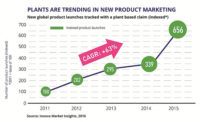A dairy industry group has released a report identifying 10 food and nutrition issues likely to impact the dairy industry in the next one to three years. Among the trends are consumer awareness of the need to consume protein and a preference for plant-based diets.
Twice a year, the Dairy Council of California, Sacramento, identifies the emergence of issues and tracks their development through multiple communication channels. The council publishes its analysis in its Trends newsletter. Following is a summary. Read the full report online (healthyeating.org) or request a hard copy of the Trends newsletter from KHouse@DairyCouncilofCA.org.
Trend 1. Dairy’s positive contributions to nutrient intakes and health are often ignored. Consumption of milk and dairy foods continues to be linked to better nutrient intakes and health outcomes (prevention of heart disease, metabolic syndrome and diabetes and better weight management).
However, public health advocates and other health professionals do not consistently endorse dairy foods. While the 2015–2020 Dietary Guidelines for Americans (DGAs) advise two or three daily servings of dairy in eating patterns, consumers sometimes reach for milk substitutes such as almond, rice and soy products.
The industry can intensify efforts to develop innovative milk and dairy products that are tasty, convenient, affordable and nutritious to compete with alternative beverages.
Trend 2. Plant-based eating patterns are on the rise due to many factors. Until recently, plant-based eating patterns were advocated primarily for their health benefits and chronic disease-fighting attributes. Now, the popularity of these patterns is growing due to economics, animal welfare concerns and sustainability needs.
Many public health groups promote diets based on plant foods. Milk and dairy foods may or may not be included in these plant-based patterns. Dairy foods can also be marketed as natural and minimally processed, to fit into the plant-based movement. Health professionals and consumers will need reminders that “plant-based” does not mean “plant-only,” and indeed, for long-term health and well-being, meat and dairy foods can be consumed.
Trend 3. The quest for protein intensifies; plant proteins are in the limelight. Protein continues to be the “nutrient of the decade” as its list of health benefits grows beyond muscle-building to include satiety and weight-management benefits, blood-glucose control, bone health and healthy aging.
Consumers are seeking protein sources at every meal and snack, but alongside the move toward plant-based diets, plant-derived protein sources are increasingly popular. Meat, eggs and dairy — traditionally excellent sources of protein — are often overlooked for new and innovative proteins such as hemp, pea, quinoa, tempeh, spirulina and even insect. There is little talk or awareness about protein quality, of which animal sources are unparalleled.
Trend 4. Disease is down-aging, opening opportunities for nutrition education. Obesity rates continue to rise slowly across the United States. Incidence of diabetes and metabolic syndrome are also increasing with a predicted one-in-three Americans having type 2 diabetes by 2050. Children are being diagnosed with these chronic diseases at younger ages.
To reduce lifelong health care costs and to optimize quality of life, more focus will be on prevention at early ages. Emphasis needs to be placed on nutrition education, using parents as the gatekeepers to children’s healthy food choices.
Trend 5. Food choices are increasingly based on consumer values beyond nutrition. Personal values about food as it relates to a higher cause — such as animal welfare, feeding the world and environmental concerns — are increasingly driving food choices.
Transparency and communication will be critical to maintain the trust of often-skeptical consumers. In an inclusive manner, Dairy Council of California acknowledges the many reasons for food choices and provides messages on dairy industry efforts to improve sustainability and animal welfare.
Trend 6. Stakeholders are taking a more holistic approach to health. A broader definition of health — one that encompasses good nutrition and includes proper sleep, stress reduction and improved mental health — is being embraced by stakeholders.
Such an approach requires community-based, multifaceted efforts that might involve, for example, building parks and sidewalks to encourage physical activity, requiring healthy food options for all students in schools, charging higher prices for less healthy products in the marketplace and facilitating farmers markets at hospitals and other community venues.
Trend 7. Nutrition education channels are changing. Paper-and-pencil nutrition education programs are no longer the gold standard for teaching healthy eating habits. Mobile and increasingly time-stressed consumers expect information to be readily available when and where they want it, packaged in short bites that are quick to assimilate.
Technology-based personalized messaging is critical to reach tech-savvy children and parents. Traditional settings such as schools and doctors’ offices are still important venues, but effective messages will need to be spread through multiple touch points such as grocery and drug stores, gyms, workplaces and even restaurants.
Trend 8. There is growing acknowledgment that health inequities are linked to socioeconomic status. Low-income populations are at higher risk of food insecurity, obesity, type 2 diabetes, lipid abnormalities and mental health issues, and it is increasingly clear that these issues are linked to socioeconomic status.
At the same time, changes in health behaviors are limited due to inadequate resources, lack of time and motivation and other priorities. This becomes a vicious cycle, and often the only perceived solution may be to improve — and sometimes legislate — the environment of local communities so default food-choice decisions are the healthiest ones. This approach of adjusting the environment to optimize health decisions is termed the behavioral economics model.
Trend 9. The growing distrust of science, the government and the food industry results in consumers forging their own nutritional path.
Consumers often self-diagnose and make decisions regarding health and food choices based on shared symptoms and on what works for others, leading to “free from” diets such as gluten-free, GMO-free, lactose-free, meat-free and dairy-free. Such diets, if followed rigorously over a period of time, may result in unintended consequences such as nutrient deficiencies and related health maladies.
The results of research funded by the industry are often marginalized due to perceived bias. To minimize that bias, industry-funded research should be subjected to a very rigorous scientific process involving expert reviewers and published in peer-reviewed journals.
Trend 10. Sustainability approaches broaden to encompass waste and packaging. Efforts to improve the sustainability of food-production practices, which originally focused on reducing greenhouse gas emissions, have expanded to include factors such as reducing waste, minimizing water usage and using packaging materials that are recyclable or biodegradable.


